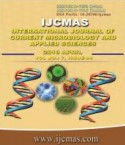


 National Academy of Agricultural Sciences (NAAS)
National Academy of Agricultural Sciences (NAAS)

|
PRINT ISSN : 2319-7692
Online ISSN : 2319-7706 Issues : 12 per year Publisher : Excellent Publishers Email : editorijcmas@gmail.com / submit@ijcmas.com Editor-in-chief: Dr.M.Prakash Index Copernicus ICV 2018: 95.39 NAAS RATING 2020: 5.38 |
This study investigates the effectiveness of water quality index (WQI) for the assessment of aesthetic status of Powai lake by analysing selected parameters. Water quality was monitored monthly for a period of one year (November, 2016 to October, 2017) in five sampling stations (A, B, C, D and E) as a simple pollution indicator for an assessment to initiate appropriate management action. The result reveal that WQIobj did not support the results of analysis of variance simply because it is calculated using many variables to assess the overall water quality. The WQImin yielded high scores (69.07) compared to the WQIobj (63.80). However, WQImin was not able to differentiate the reference station and the others to a large extent, though some signiï¬Âcant differences for the entire months were observed. This ï¬Ânding was further supported by individual level of concentration between the WQIobj and the WQImin index scores. The results suggested that water temperature, turbidity, and total phosphate along with carbon dioxide depend on monsoon as a result of the discharges into the lake. A calculation of WQImin based on eight parameters confirmed that water quality of the lake can be classified as “fair” however which a condition sometimes depart from natural or desirable levels (average scores between 65 and 79 in annual period) due to varying extent of environmental and anthropogenic factor. Furthermore, WQImin can be used as tool for assessment of water quality and employed in monitoring of aquatic body, because it decreases the cost of monitoring of the lake. Overall, the study shows that WQI is an effective parameter to evaluate the water quality of the lake which has a potential for aquaculture especially cage culture.
 |
 |
 |
 |
 |